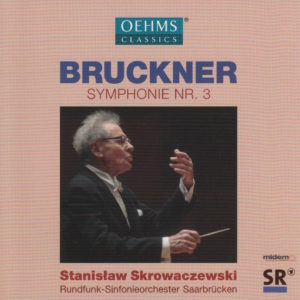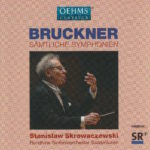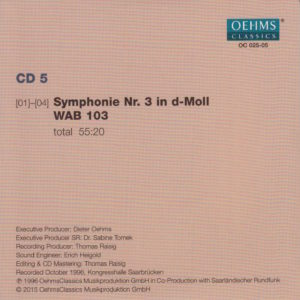 This morning’s conductor of Anton Bruckner’s Symphony No. 3 in D Minor (WAB 103), nicknamed “Wagner,” is Stanislaw Skrowaczewski (1923-), the famed Polish-born artist who even has a web site with a cool name: Seeking The Infinite, which is also the title of a biography about him. You can find it here.
This morning’s conductor of Anton Bruckner’s Symphony No. 3 in D Minor (WAB 103), nicknamed “Wagner,” is Stanislaw Skrowaczewski (1923-), the famed Polish-born artist who even has a web site with a cool name: Seeking The Infinite, which is also the title of a biography about him. You can find it here.
I first encountered Maestro Skrowaczewski on Day 13 and on Day 29.
 If you’re interested in bio information about him, click on one of those two links. Or click here to be taken to his entry on Wikipedia. Whatever floats your boat.
If you’re interested in bio information about him, click on one of those two links. Or click here to be taken to his entry on Wikipedia. Whatever floats your boat.
I gotta say this would be a fine box set if the liner notes contained and/or more clearly indicated which version of Bruckner’s symphonies the conductor chose. Seriously. Skrowaczewski is a world-class conductor. Ditto for the fame of Rundfunk-Sinfonieorchester Saarbrucken. Would it have killed someone at OEHMS Classics (the record label that released this box set) to have included just a skosh more information for lovers of Bruckner and/or Skrowaczewski? To discover which version Skrowaczewski used, I had to look at all printed material (box, CD sleeve, booklet) and read through the liner notes (written by Barbara Dobretsberger) in the section ostensibly for the Third Symphony, which reads:
The composition of the Third Symphony, which was re-written no less than three times, set great energies free in Bruckner – the Fourth Symphony followed a year later and a year after that, the Fifth. The version recorded here is the definitive 1889 version, which, considering the time which Bruckner spent revising and perfecting it, can be taken as a prime example of his extreme sensitivity to contemporary criticism.
The boldface was is in the original, making it somewhat confusing regarding which symphony I was reading about. I believe I correctly gleaned that the version Skrowaczeski chose for the Third Symphony was “the definitive 1889 version.” But who edited it? Why is it referred to as “definitive”? Why a conductor chose a particular version is as much a story to me as how it’s performed. But that information is lacking in these notes. (To be fair, I think the specific why is only part of the DG Jochum and Brilliant Classics Tintner box sets. Both conductors really seemed to understand and revere Anton Bruckner.)
 Take a look at what’s on the back of the CD sleeve.
Take a look at what’s on the back of the CD sleeve.
The record label didn’t even bother to break down the names of the movements, let alone tell me who the orchestra is. Or even the name of the conductor, for that matter. (Granted, the names of the conductor and orchestra are on the front of the sleeve. But, still, how much more time would it have taken to type the information again on the back?). And, heaven forbid, there’s ZERO information on the CD sleeve about which version of the symphony Maestro Skrowaczewski used. Since version is one of the differentiating factors when it comes to Bruckner’s symphonies, I don’t consider that information optional. It should be easy to find, printed everywhere – not just buried in the body of an essay. Ditto for where and when this symphony was recorded. A small italicized sentence on the last inside page of the CD booklet reads:
For recording details please refer to backcovers of the CD sleeves.
The problem with this arrangement is that if someone wants to know what he/she is hearing (all the details), he/she needs to bring the booklet/liner notes and the CD sleeves because their combined information gives the complete picture – with the notable exception that information about the version is scant, if altogether missing.
Before I type any more obvious opinions, here are the nuts and bolts (the objective aspects) of this morning’s listening experience:
Bruckner’s Symphony No. 3 in D Minor, composed in 1873
Stanislaw Skrowaczewski conducts
The version Skrowaczewski used is, what the booklet calls, “the definitive 1889 version.”
Rundfunk-Sinfonieorchester Saarbrucken plays
The symphony clocks in at 55:20
This was recorded in October of 1996 at Kongresshalle Saarbrucken in Germany
Skrowaczewski was 73 when he conducted it
Bruckner was 49 when he composed it
This recording was released on the OEHMS Classics record label
Bruckner wrote his symphonies in four parts. The time breakdown of this one (Symphony No. 3 in D Minor, “the definitive 1889 version”), from this particular conductor (Skrowaczewski) and this particular orchestra (Rundfunk-Sinfonieorchester Saarbrucken) is as follows:
Moderato (Mehr langsam, misterioso, officially)………………………….18:59
Adagio (Bewegt, quasi Andante, officially)…………………………………….15:36
Scherzo (Ziemlich schnell) ……………………………………………………………..7:03
Allegro……………………………………………………………………………………………14:23
Total: 55:20
Okay. Now for the subjective stuff…
My Rating:
Recording quality: 4
Overall musicianship: 5
CD liner notes: 3 (lengthy essays, but incomplete recording/version information)
How does this make me feel: 4
I really like performances by Stanislaw Skrowaczewski. These recordings are majestic, compelling, powerful, and sweeping in their scope. I realize he’s only working with what Bruckner composed. Yet, in his hands, Bruckner’s Third really comes alive.
Of particular interest to me were Movement III and Movement IV, although the Finale seemed to peter out with a whimper rather than a bang. Still, the dynamics throughout were marvelous. And few pieces of music ever written begin with as much drama and boldness as the first 30 seconds or so of Movement III. It’s the musical equivalent of a supernova exploding.
I liked everything about this recording, not least of which is that the brass instruments (which, to me, can sound harsh or blaring in some recordings) were sufficiently muted.
Highly recommended.
